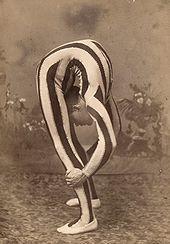A backbend is a gymnastics, contortion, dance and ice skating move, where the spine is bent backwards, and catching oneself with the hands. Throughout the move, the abdominal muscles, obliques, and legs are used to steady the performer while curving backwards. Modern yoga includes some backbending asanas. Backbending can be acquired from intense training or genetics.
Overview
The spine consists of 24 vertebrae and between the vertebrae are small cushions referred to as disks. The movement of the vertebrae and the compression ability of the disks give the spine its flexibility.
It is easier to perform a backbend after mastering a bridge. A bridge helps familiarize the bones and muscles to the positions and movements of a backbend.
There are over a dozen yoga positions that are variant of the backbend.[1][2] A "rib thrust" is common and deleterious to a good yoga pose,[3] and one of the more common of several errors associated with the backbend.[2][4]
Uses
The backbend is important in gymnastics because it is essential to perform a back handspring.
Backbends are part of the repertoire of professional and competitive ice skaters. For example, a backbend was performed by Jimmie Santee in the 1994 production of Walt Disney's World on Ice: Aladdin. Backbends and other contortions were a feature of the performance of Mr. Frick from the 1930s ice comedy act Frick and Frack.[5]
Backbending asanas
Modern yoga includes backbending asanas such as the kneeling Kapotasana and Ustrasana, the inverted Urdhva Dhanurasana, and the sitting Rajakapotasana. These are described as "strenuous"[6] poses, and should be worked on gently by beginners or people with stiff backs to avoid injury.[6] The spine can be released after backbending asanas with twisting asanas such as Marichyasana and Matsyendrasana, or by forward bends such as Janusirsasana, practised gently.[6]
See also
References
- ^ "Backbends". Yoga Journal. Retrieved October 29, 2018.
- ^ a b Spindler, Beth. "3 Common Backbend Mistakes (And How to Fix Them)". Yoga International. Retrieved October 29, 2018.
- ^ "When is a Backbend Not a Proper Backbend". November 13, 2017. Retrieved October 29, 2018.
- ^ Schneider, Howard (November 4, 2008). "Yoga Can Give You Strength, Balance, Flexibility. Isn't That Enough?". The Washington Post. Archived from the original on October 30, 2018. Retrieved October 29, 2018 – via HighBeam Research.(subscription required)
- ^ Molter, Dave (March 3, 1994). "'Aladdin on Ice' Goes Down Nice". Observer-Reporter. p. B6. Retrieved October 29, 2018.
- ^ a b c Mehta, Silva; Mehta, Mira; Mehta, Shyam (1990). Yoga: The Iyengar Way. Dorling Kindersley. pp. 133–144. ISBN 978-0-86318-420-8.
